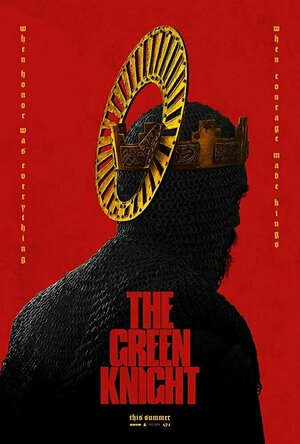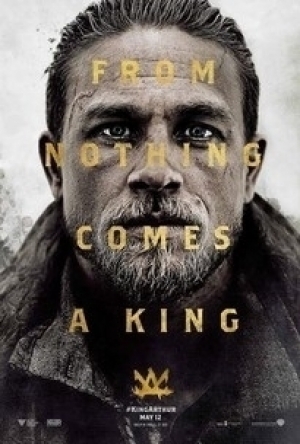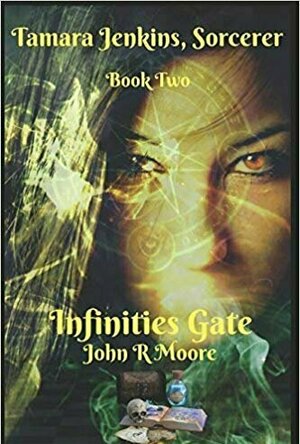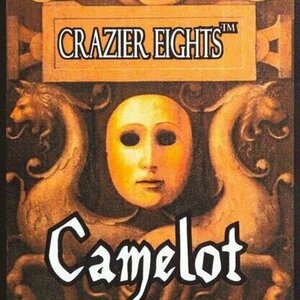Search
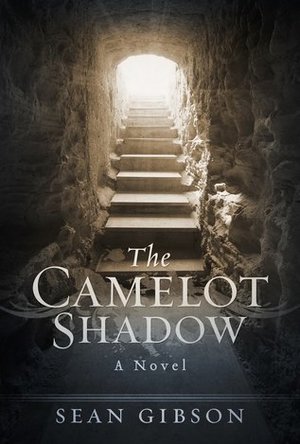
The Camelot Shadow
Book
"A chance to save her. Improbably, impossibly, inconceivably." Lord Alfred Fitzwilliam spends...
LeftSideCut (3776 KP) rated The Green Knight (2020) in Movies
Sep 29, 2021
It's now been three days since I watched The Green Knight and I haven't able to get it out of my head, it's strong combination of layered narrative and stunning visuals really leave an impression.
The themes running through the film are many. It presents itself as a coming of age tale, but is primarily about the conflict of pride and honour, and what one is willing to do to leave a legend in their stead. All of these threads are executed wonderfully under the skin of a fantasy voyage. The fantasy setting has a near constant feeling of dread running through it. There are moments here and there that flirt with horror, and are genuinely unsettling, thanks in no small part to a unnerving music score by Daniel Hart, a frequent collaborater of director David Lowery. His score draws you in to the point of not being able to look away, even when you want to.
As mentioned, The Green Knight is visually stunning, an unarguable feast for the eyes. The whole runtime is bursting with beautiful vistas, colourful fever dreams, inspired perspective shots, and some moments that are designed to stick in the mind, rent free. The whole aesthetic and world design feels unique, the titular Green Knight being a fine example.
It has a top tier cast just to really sweeten the deal as well.
All of these aspects combined make for an engaging Arthurian tale that is hard to forget. It surely won't be to everyone's liking, but as far as I'm concerned, it's an excellent piece of film making that absolutely deserves to be seen regardless.
The themes running through the film are many. It presents itself as a coming of age tale, but is primarily about the conflict of pride and honour, and what one is willing to do to leave a legend in their stead. All of these threads are executed wonderfully under the skin of a fantasy voyage. The fantasy setting has a near constant feeling of dread running through it. There are moments here and there that flirt with horror, and are genuinely unsettling, thanks in no small part to a unnerving music score by Daniel Hart, a frequent collaborater of director David Lowery. His score draws you in to the point of not being able to look away, even when you want to.
As mentioned, The Green Knight is visually stunning, an unarguable feast for the eyes. The whole runtime is bursting with beautiful vistas, colourful fever dreams, inspired perspective shots, and some moments that are designed to stick in the mind, rent free. The whole aesthetic and world design feels unique, the titular Green Knight being a fine example.
It has a top tier cast just to really sweeten the deal as well.
All of these aspects combined make for an engaging Arthurian tale that is hard to forget. It surely won't be to everyone's liking, but as far as I'm concerned, it's an excellent piece of film making that absolutely deserves to be seen regardless.
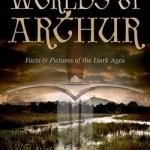
Worlds of Arthur: Facts and Fictions of the Dark Ages
Book
King Arthur is probably the most famous and certainly the most legendary medieval king. From the...
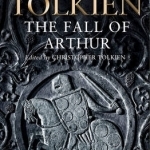
The Fall of Arthur
J.R.R. Tolkien and Christopher Tolkien
Book
The world first publication of a previously unknown work by J.R.R. Tolkien, which tells the...
Gareth von Kallenbach (980 KP) rated King Arthur: Legend Of The Sword (2017) in Movies
Jun 19, 2019
Over countless decades the legend of King Arthur has been depicted across a range of mediums. The timeless tale of love, betrayals, action, and adventure has remained a popular and enduring tale ever since it was first introduced.
Director Guy Ritchie has crafted a very different take on the tale as he even contributed to the screenplay for the film. As such “King Arthur: Legend of the Sword”, is brimming with many of his signature elements ranging from a caper story and characters who are filled with quirks and issues.
Charlie Hunnam plays Arthur who is orphaned at an early age when his family is betrayed by his Uncle Vortigern (Jude Law). Arthur is raised in a London brothel with no knowledge of his true lineage.
Arthur learns combat and life on the streets and quickly learns how to make money through various dealings, some of which are not exactly on the level. This is where Ritchie shows his trademark style as there is a caper element to the early part of the story and a scene of Arthur and his pals walking through the aftermath of an event is complete with his signature, start, stop, and rewind moments that made up his recent “Sherlock Holmes” films.
Naturally events put Arthur and Vortigern against each other when Arthur is able to pull the legendary Excalibur from a stone as part of a test imposed on all young men of a certain age.
With his true identity in place, Arthur is marked by his Uncle as he is the only threat to his power and this forces Arthur into the protection of the resistance where he must embrace his past and find his destiny.
The film does take some liberties with the Arthurian Legend and does go a bit heavy on the FX especially with the inclusion of giant creatures which made me think at times I was watching something from the “Lord of the Rings”. The film does drag in parts but does rebound with a finale that seemed very video game esque, but sets up future films well. The cast is strong and there is plenty to like about the film as long as you are willing to be patient with the pacing of the film.
http://sknr.net/2017/05/10/king-arthur-legend-sword/
Director Guy Ritchie has crafted a very different take on the tale as he even contributed to the screenplay for the film. As such “King Arthur: Legend of the Sword”, is brimming with many of his signature elements ranging from a caper story and characters who are filled with quirks and issues.
Charlie Hunnam plays Arthur who is orphaned at an early age when his family is betrayed by his Uncle Vortigern (Jude Law). Arthur is raised in a London brothel with no knowledge of his true lineage.
Arthur learns combat and life on the streets and quickly learns how to make money through various dealings, some of which are not exactly on the level. This is where Ritchie shows his trademark style as there is a caper element to the early part of the story and a scene of Arthur and his pals walking through the aftermath of an event is complete with his signature, start, stop, and rewind moments that made up his recent “Sherlock Holmes” films.
Naturally events put Arthur and Vortigern against each other when Arthur is able to pull the legendary Excalibur from a stone as part of a test imposed on all young men of a certain age.
With his true identity in place, Arthur is marked by his Uncle as he is the only threat to his power and this forces Arthur into the protection of the resistance where he must embrace his past and find his destiny.
The film does take some liberties with the Arthurian Legend and does go a bit heavy on the FX especially with the inclusion of giant creatures which made me think at times I was watching something from the “Lord of the Rings”. The film does drag in parts but does rebound with a finale that seemed very video game esque, but sets up future films well. The cast is strong and there is plenty to like about the film as long as you are willing to be patient with the pacing of the film.
http://sknr.net/2017/05/10/king-arthur-legend-sword/
BookwormMama14 (18 KP) rated Chivalrous (Valiant Hearts, #2) in Books
Jan 2, 2019
In 1217 the daughter of a baron has but one obligation in life: To marry the man her father chooses and continue the family line. But what if said daughter wished for something different, what if her heart's desire was to become a knight?
"Gwen felt no fear, only the surge of battle coursing through her. Steeling her. Strengthening her."
Gwendolyn Barnes longs to be be a chivalrous knight like her brothers. But her ruthless father has plans to marry her to a man who is able to break her free spirit. She is expected to become a meek and submissive wife to whomever her father chooses. Even in the Arthurian-inspired land of North Britannia Gwen is expected to concede to her parents decisions. But when Sir Allen comes to Edendale, Gwen finds herself longing for a family of her own, if Sir Allen were the one she was wed to. When tragedy befalls the land they must make their choices. Ones which could separate them forever. Will the love Gwen has found be lost forever? Will she be forced to marry a brute of a man? Will Sir Allen, the hope of the land, be able to save them all from destruction?
"She would cling tight to her shield of faith. God would be her defense."
Chivalrous is a riveting story of faith, hope and love. As I was reading I was constantly reminded of the Disney movie Brave (which is one of my favorites). Dina Sleiman's Valiant Hearts series is incredible! I love imagining what it would have been like to live in medieval England. However, it is hard for me to fathom being born into a culture that does not allow a person to choose their own future. To be bound by rules and regulations that dictate your every waking moment. It makes me grateful to be born in the time I was. There is a lot of emotions experienced in this book. But through it all the message is clear. Never give up! Keep fighting for what is right and true. And God will be with us every step of the way, guiding us into our destiny.
I received a free digital copy of Chivalrous from Bethany House Publishing through NetGalley in exchange for my honest review.
"Gwen felt no fear, only the surge of battle coursing through her. Steeling her. Strengthening her."
Gwendolyn Barnes longs to be be a chivalrous knight like her brothers. But her ruthless father has plans to marry her to a man who is able to break her free spirit. She is expected to become a meek and submissive wife to whomever her father chooses. Even in the Arthurian-inspired land of North Britannia Gwen is expected to concede to her parents decisions. But when Sir Allen comes to Edendale, Gwen finds herself longing for a family of her own, if Sir Allen were the one she was wed to. When tragedy befalls the land they must make their choices. Ones which could separate them forever. Will the love Gwen has found be lost forever? Will she be forced to marry a brute of a man? Will Sir Allen, the hope of the land, be able to save them all from destruction?
"She would cling tight to her shield of faith. God would be her defense."
Chivalrous is a riveting story of faith, hope and love. As I was reading I was constantly reminded of the Disney movie Brave (which is one of my favorites). Dina Sleiman's Valiant Hearts series is incredible! I love imagining what it would have been like to live in medieval England. However, it is hard for me to fathom being born into a culture that does not allow a person to choose their own future. To be bound by rules and regulations that dictate your every waking moment. It makes me grateful to be born in the time I was. There is a lot of emotions experienced in this book. But through it all the message is clear. Never give up! Keep fighting for what is right and true. And God will be with us every step of the way, guiding us into our destiny.
I received a free digital copy of Chivalrous from Bethany House Publishing through NetGalley in exchange for my honest review.
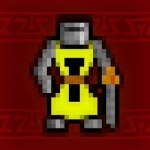
Warlords Classic - official port from Mac/PC/Amiga
Games
App
Warlords Classic is an official port of the fabulous game you have been playing in your childhood on...
EmersonRose (320 KP) rated Infinities Gate in Books
Nov 20, 2019
“At the Equinox, a bright blue glow engulfed the entire hill. Above the monument, a vortex opened and sucked them into its eye. When the light faded, they were gone.”
Infinities Gate is the second book in the Tamara Jenkins, Sorcerer series by author John R. Moore. It tells the story of archaeology professor Tamara Jenkins and the magical world of wizards she does not just fall into but becomes one of the greatest wizards and leader against the fight against darkness. In this book, Tamara and her husband mysteriously disappear on their honeymoon, and it is up to their friends to find them. Along the way, they discover the Infinities Gate and realize that they must keep the gate from opening or risk releasing chaos itself. When talking about his book series Moore says it is “In the order of Indiana Jones crossed with Merlin.” This statement perfectly sums up the atmosphere of the book. This was the crossover I never knew I needed. This mashup was an imaginative and clever premise that immediately had me hooked into the first book which continued into the second.
The story begins quickly, showering you with information, questions, and mysteries. This kind of beginning hooked my attention immediately and made it hard to put the book down. This story is filled with mysteries, interesting twists, and exciting adventures. From wizards to Norse gods, Moore delves into the fantastical intricacies of myths and legends while still making the stories his own. You can’t help but root for Tamara as she makes her way through these magical adventures. I really liked seeing her growth in both books and found her to be an interesting and fun heroine to follow on this journey.
The Celtic and Scottish history is something I love learning about so getting to read about it, and the magical side of it was very exciting for me. My love for both Indiana Jones and Arthurian legend fueled this fascination with this story. From the very beginning of the book, it connected itself to these histories and had events taking place in some of the most magical feeling places in the world like Stonehenge and the Isle of the Sky. This setting brought the magic and history into the book beautifully.
I was very impressed with Moore’s writing style. His descriptions of the world are beautiful as is his attention to the details of history. His characters have a depth which is integral for me in any book I read. I enjoyed reading this series so much I am excited to look into some of his other work. His interest in science fiction and fantasy stories align very much with my favorite genres to read. I cannot wait for the third book in this series so I can continue my journey with the wonderful Tamara. This was a very enjoyable book that offered a quick read into a magical world. I would highly recommend this book to fantasy readers!
Infinities Gate is the second book in the Tamara Jenkins, Sorcerer series by author John R. Moore. It tells the story of archaeology professor Tamara Jenkins and the magical world of wizards she does not just fall into but becomes one of the greatest wizards and leader against the fight against darkness. In this book, Tamara and her husband mysteriously disappear on their honeymoon, and it is up to their friends to find them. Along the way, they discover the Infinities Gate and realize that they must keep the gate from opening or risk releasing chaos itself. When talking about his book series Moore says it is “In the order of Indiana Jones crossed with Merlin.” This statement perfectly sums up the atmosphere of the book. This was the crossover I never knew I needed. This mashup was an imaginative and clever premise that immediately had me hooked into the first book which continued into the second.
The story begins quickly, showering you with information, questions, and mysteries. This kind of beginning hooked my attention immediately and made it hard to put the book down. This story is filled with mysteries, interesting twists, and exciting adventures. From wizards to Norse gods, Moore delves into the fantastical intricacies of myths and legends while still making the stories his own. You can’t help but root for Tamara as she makes her way through these magical adventures. I really liked seeing her growth in both books and found her to be an interesting and fun heroine to follow on this journey.
The Celtic and Scottish history is something I love learning about so getting to read about it, and the magical side of it was very exciting for me. My love for both Indiana Jones and Arthurian legend fueled this fascination with this story. From the very beginning of the book, it connected itself to these histories and had events taking place in some of the most magical feeling places in the world like Stonehenge and the Isle of the Sky. This setting brought the magic and history into the book beautifully.
I was very impressed with Moore’s writing style. His descriptions of the world are beautiful as is his attention to the details of history. His characters have a depth which is integral for me in any book I read. I enjoyed reading this series so much I am excited to look into some of his other work. His interest in science fiction and fantasy stories align very much with my favorite genres to read. I cannot wait for the third book in this series so I can continue my journey with the wonderful Tamara. This was a very enjoyable book that offered a quick read into a magical world. I would highly recommend this book to fantasy readers!
Purple Phoenix Games (2266 KP) rated Crazier Eights: Camelot in Tabletop Games
Dec 23, 2020
DISCLAIMER: We have previously reviewed Crazier Eights: Olympus and Crazier Eights: Pantheon, and this preview has much of the same verbiage as the family of games share most things. Near the end of the preview are my thoughts about the differences in Camelot vs Olympus and Pantheon.
War. Old Maid. Go Fish. Crazy Eights. These are classic card games we probably all grew up playing. There have been many re-themes and new difficulty layers spread upon them to make them even more interesting. While UNO certainly has cornered the market on the Crazy Eights base, we have a new contender: Crazier Eights. Recoculous has published several versions of this card game with different themes: Avalon, One Thousand & One Nights, Olympus, and Shahrzad. Today we are taking a preview of Crazier Eights: Camelot.
You HAVE played Crazy Eights right? The card game where you attempt to be the first to exhaust your hand of cards, but you can only play down if you can match the suit or number on top of the discard pile? And if you can’t, you throw down an 8 as a wild and call the color to be played next? Well there you have the easy rules. Crazier Eights: Camelot (which I will from here call C8C) holds basically the same rule-set with a few new mechanics and a theme. The win condition is still the same: be the first to exhaust your hand of cards, but to win you will need to play your hand strategically against your opponents.
DISCLAIMER: We were provided a copy of this game for the purposes of this review. This is a retail copy of the game, so what you see in these photos is exactly what would be received in your box. I do not intend to cover every single rule included in the rulebook, but will describe the overall game flow and major rule set so that our readers may get a sense of how the game plays. For more in depth rules, you may purchase a copy online or from your FLGS. -T
To setup, shuffle the large deck of cards and place the deck in the middle of the table. Flip the top card to begin the discard pile and dictate the first card play. Deal each player seven cards and you are ready to begin!
The turn structure is familiar: check for any “start of turn” effects and apply them, draw a card, play and/or discard a card, then resolve any “end of turn” effects. The deck is comprised of Events and Assets in different colors (suits) and numbers like in a typical deck of playing cards. After checking and resolving start of turn effects on Asset cards in your personal tableau, you must draw a card from the deck. This is where C8C strays from OG Crazy Eights a bit. You may play a card from your hand (Assets and Events) and discard a card to the discard pile (matching the suit/number/or an Eight), or simply play a card from your hand without discarding. Cards played from your hand can be Event cards that are played, resolved, and then discarded to the bottom of the discard pile, or an Asset card that is played to your tableau that cause chain reactions or other abilities on future turns. Next, resolve any end of turn effects from Assets in your tableau before the next player begins their turn.
Play continues in this fashion until one player has rid themselves of their hand and is crowned the Master of the Camelot! Or at least, the winner of the game.
Components. This game is a box full of cards. The cards are good. The layout makes sense, and the art on the faces of the cards remind me of very classic art depicting ancient Arthurian scenes. I am no art historian, so I do not know if they are existing art pieces or new ones crafted for this game, but either way, they are a joy to behold… if you can spend the time appreciating the art instead of tracking what cards you need to play and what effects you can chain together (that was me). Extra points to the Recoculous team for associating symbols with the different suit colors for our colorblind friends. This is something that unfortunately goes unaddressed far too often.
This implementation is the third Crazier Eights we have had the chance to try, and I can say that we really enjoyed our plays of it (we played Olympus first and recently also reviewed Pantheon). The game comes with many interesting and varied effects to craft an ingenious strategy, and the art is stellar. Beware of playing with AP-prone gamers, as there is a lot going on and it is more than just a skinned Crazy Eights.
This Camelot set is slightly different than our previous experiences with both Olympus and Pantheon in a few ways. Firstly, it is more of a base game deck like Olympus instead of a standalone/expansion like Pantheon. Secondly, this set seems to use more cards that affect the assets of other players, specifically in destroying them. Additionally, I have noticed a few cards in the deck that specifically say if certain criteria are met one player automatically wins or loses the game. That’s it. Done-zo. Maybe I missed these cards in the other sets, but I do not remember them ever surfacing. Having each set focus on different aspects of the game and the manipulation of the rules ever so slightly to affect a player’s strategy from one set to the next is quite enchanting to me. Could you put all the sets together to make a massive meta-deck a la Munchkin with all the sets and expansions? Probably, but like Munchkin, I probably would rather keep them separate.
Now having played this family of games several times, I can say that it is my favorite Crazy Eights derivative and certainly worthy of a look. If your game collection is sorely lacking in Arthurian-themed card games, or if you want a hybrid game of old school rules with interesting twists, then do consider purchasing this or one of its predecessors.
PS – Don’t worry if, while you are playing, you have all your Assets stolen or destroyed. I have won the game with zero Assets in front of me while opponents have had eight, ironically. Assets are great, but you still need to shed your hand.
War. Old Maid. Go Fish. Crazy Eights. These are classic card games we probably all grew up playing. There have been many re-themes and new difficulty layers spread upon them to make them even more interesting. While UNO certainly has cornered the market on the Crazy Eights base, we have a new contender: Crazier Eights. Recoculous has published several versions of this card game with different themes: Avalon, One Thousand & One Nights, Olympus, and Shahrzad. Today we are taking a preview of Crazier Eights: Camelot.
You HAVE played Crazy Eights right? The card game where you attempt to be the first to exhaust your hand of cards, but you can only play down if you can match the suit or number on top of the discard pile? And if you can’t, you throw down an 8 as a wild and call the color to be played next? Well there you have the easy rules. Crazier Eights: Camelot (which I will from here call C8C) holds basically the same rule-set with a few new mechanics and a theme. The win condition is still the same: be the first to exhaust your hand of cards, but to win you will need to play your hand strategically against your opponents.
DISCLAIMER: We were provided a copy of this game for the purposes of this review. This is a retail copy of the game, so what you see in these photos is exactly what would be received in your box. I do not intend to cover every single rule included in the rulebook, but will describe the overall game flow and major rule set so that our readers may get a sense of how the game plays. For more in depth rules, you may purchase a copy online or from your FLGS. -T
To setup, shuffle the large deck of cards and place the deck in the middle of the table. Flip the top card to begin the discard pile and dictate the first card play. Deal each player seven cards and you are ready to begin!
The turn structure is familiar: check for any “start of turn” effects and apply them, draw a card, play and/or discard a card, then resolve any “end of turn” effects. The deck is comprised of Events and Assets in different colors (suits) and numbers like in a typical deck of playing cards. After checking and resolving start of turn effects on Asset cards in your personal tableau, you must draw a card from the deck. This is where C8C strays from OG Crazy Eights a bit. You may play a card from your hand (Assets and Events) and discard a card to the discard pile (matching the suit/number/or an Eight), or simply play a card from your hand without discarding. Cards played from your hand can be Event cards that are played, resolved, and then discarded to the bottom of the discard pile, or an Asset card that is played to your tableau that cause chain reactions or other abilities on future turns. Next, resolve any end of turn effects from Assets in your tableau before the next player begins their turn.
Play continues in this fashion until one player has rid themselves of their hand and is crowned the Master of the Camelot! Or at least, the winner of the game.
Components. This game is a box full of cards. The cards are good. The layout makes sense, and the art on the faces of the cards remind me of very classic art depicting ancient Arthurian scenes. I am no art historian, so I do not know if they are existing art pieces or new ones crafted for this game, but either way, they are a joy to behold… if you can spend the time appreciating the art instead of tracking what cards you need to play and what effects you can chain together (that was me). Extra points to the Recoculous team for associating symbols with the different suit colors for our colorblind friends. This is something that unfortunately goes unaddressed far too often.
This implementation is the third Crazier Eights we have had the chance to try, and I can say that we really enjoyed our plays of it (we played Olympus first and recently also reviewed Pantheon). The game comes with many interesting and varied effects to craft an ingenious strategy, and the art is stellar. Beware of playing with AP-prone gamers, as there is a lot going on and it is more than just a skinned Crazy Eights.
This Camelot set is slightly different than our previous experiences with both Olympus and Pantheon in a few ways. Firstly, it is more of a base game deck like Olympus instead of a standalone/expansion like Pantheon. Secondly, this set seems to use more cards that affect the assets of other players, specifically in destroying them. Additionally, I have noticed a few cards in the deck that specifically say if certain criteria are met one player automatically wins or loses the game. That’s it. Done-zo. Maybe I missed these cards in the other sets, but I do not remember them ever surfacing. Having each set focus on different aspects of the game and the manipulation of the rules ever so slightly to affect a player’s strategy from one set to the next is quite enchanting to me. Could you put all the sets together to make a massive meta-deck a la Munchkin with all the sets and expansions? Probably, but like Munchkin, I probably would rather keep them separate.
Now having played this family of games several times, I can say that it is my favorite Crazy Eights derivative and certainly worthy of a look. If your game collection is sorely lacking in Arthurian-themed card games, or if you want a hybrid game of old school rules with interesting twists, then do consider purchasing this or one of its predecessors.
PS – Don’t worry if, while you are playing, you have all your Assets stolen or destroyed. I have won the game with zero Assets in front of me while opponents have had eight, ironically. Assets are great, but you still need to shed your hand.
BankofMarquis (1832 KP) rated The Green Knight (2020) in Movies
Aug 6, 2021
Interesting...Intriguing...and Weird
You have 2 choices when choosing to view the Arthurian tale THE GREEN KNIGHT.
1). Brush up on the 14th Century tale (writer unknown) about Sir Gawain (of Knights of the Round Table fame) and The Green Knight
2). Go in “blind” and let the film wash over you.
I did #2 and while I got the “gist” of what was going on, I missed some of the subtleties (or the attempted subtleties) that I now know since I went on-line and brushed up on the story/poem (no, I did not read the 14th century poem - a google search synopsis of plot of the poem was sufficient).
Starring Dev Patel (more on him later) THE GREEN KNIGHT tells the story of a would-be Knight of the Round Table, Gawain, who accepts a challenge of THE GREEN KNIGHT and now must stand up to the consequence of his deeds while heading off on a quest.
Dev Patel (SLUMDOG MILLIONAIRE) has really grown into a fine actor and he is perfectly cast as the courage-challenged Gawain. He walks through this film with a slight look of fear in his eyes and I was finding myself yelling at him (in my head) to “stand up and do what’s right” (which is the point of the film/story) when he would make the wrong decision.
Alicia Vikander (who I have not seen on screen since 2018’s TOMB RAIDER) and Joel Edgerton (LOVING) are 2 of the people that Gawain meets along the way and they bring strength and star power to the middle part of this film - they came along at an opportune time, for this film was beginning to sag under it’s own weight at that point, but these 2 help propel Gawain (and the film) to the climax.
Director David Lowery (A GHOST STORY) has crafted a fantastical film that reminded me very much of the work of Terry Gilliam - and I mean that as a compliment. He heightens every scene with imagery that’s just “off” (again, I mean that as a compliment) that symbolizes the “quest” that Gawain is on.
He also does something that will either encourage or discourage a viewer (and that is the strength and weakness of this film) - he explains nothing.
For example…at the beginning, Gawain is sitting at a round table with a King and Queen and a bunch of other Knights (or would be Knights). One would assume that this is King Arthur, Guinevere and the Knights of the Round Table, but Lowery never calls them by name. “The King” pulls out his sword and hands it to Gawain for his contest with the Green Knight. The crowd reacts with gasps - one would assume that this is the fable sword Excaliber, but it is never stated.
So…knowing these things (and some of the other aspects of the Gawain) story, might further enrich this experience, but Lowery chooses to not spoon feed the audience and since I did not really know the Gawain story, I just sat back and enjoyed the quest, the imagery, the weirdness (and there is some VERY weird moments - I still don’t know what to make of the scene with the Giants) and was rewarded with a film experience that is rare nowadays, one that just unfurls without telescoping what is happening or what is to come.
This film is not for everyone - it does have a rather languid pace to it - but for those of you that can sit in the stillness, marvel at the imagery and revel in the weirdness/unknown, then THE GREEN KNIGHT is, ultimately, a rewarding film experience - one that (now that I know the story) am eager to revisit.
Letter Grade: B
7 Stars (out of 10) and you can take that to the Bank(ofMarquis)
1). Brush up on the 14th Century tale (writer unknown) about Sir Gawain (of Knights of the Round Table fame) and The Green Knight
2). Go in “blind” and let the film wash over you.
I did #2 and while I got the “gist” of what was going on, I missed some of the subtleties (or the attempted subtleties) that I now know since I went on-line and brushed up on the story/poem (no, I did not read the 14th century poem - a google search synopsis of plot of the poem was sufficient).
Starring Dev Patel (more on him later) THE GREEN KNIGHT tells the story of a would-be Knight of the Round Table, Gawain, who accepts a challenge of THE GREEN KNIGHT and now must stand up to the consequence of his deeds while heading off on a quest.
Dev Patel (SLUMDOG MILLIONAIRE) has really grown into a fine actor and he is perfectly cast as the courage-challenged Gawain. He walks through this film with a slight look of fear in his eyes and I was finding myself yelling at him (in my head) to “stand up and do what’s right” (which is the point of the film/story) when he would make the wrong decision.
Alicia Vikander (who I have not seen on screen since 2018’s TOMB RAIDER) and Joel Edgerton (LOVING) are 2 of the people that Gawain meets along the way and they bring strength and star power to the middle part of this film - they came along at an opportune time, for this film was beginning to sag under it’s own weight at that point, but these 2 help propel Gawain (and the film) to the climax.
Director David Lowery (A GHOST STORY) has crafted a fantastical film that reminded me very much of the work of Terry Gilliam - and I mean that as a compliment. He heightens every scene with imagery that’s just “off” (again, I mean that as a compliment) that symbolizes the “quest” that Gawain is on.
He also does something that will either encourage or discourage a viewer (and that is the strength and weakness of this film) - he explains nothing.
For example…at the beginning, Gawain is sitting at a round table with a King and Queen and a bunch of other Knights (or would be Knights). One would assume that this is King Arthur, Guinevere and the Knights of the Round Table, but Lowery never calls them by name. “The King” pulls out his sword and hands it to Gawain for his contest with the Green Knight. The crowd reacts with gasps - one would assume that this is the fable sword Excaliber, but it is never stated.
So…knowing these things (and some of the other aspects of the Gawain) story, might further enrich this experience, but Lowery chooses to not spoon feed the audience and since I did not really know the Gawain story, I just sat back and enjoyed the quest, the imagery, the weirdness (and there is some VERY weird moments - I still don’t know what to make of the scene with the Giants) and was rewarded with a film experience that is rare nowadays, one that just unfurls without telescoping what is happening or what is to come.
This film is not for everyone - it does have a rather languid pace to it - but for those of you that can sit in the stillness, marvel at the imagery and revel in the weirdness/unknown, then THE GREEN KNIGHT is, ultimately, a rewarding film experience - one that (now that I know the story) am eager to revisit.
Letter Grade: B
7 Stars (out of 10) and you can take that to the Bank(ofMarquis)
